








THE STORY OF JACK
Airedale Jack was sent to France with the Sherwood Foresters and saved an entire battalion, cut off from communication and under attack four miles behind enemy lines.
Jack came to the rescue. The vital message was slipped into a pouch on his collar. A pat on the head and then simply:
“Goodbye Jack … go back, boy”.
The battalion watched Jack slip quietly away with shells falling all around him. A piece of shrapnel smashed his jaw … but he carried on. Another missile tore open his tough, black and tan coat but on he crawled, making it back to HQ with the vital message. Unfortunately, Jack died moments after delivering the message due to his injuries.
He was awarded a posthumous animal VC.


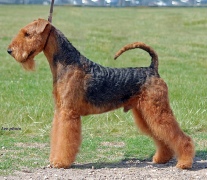
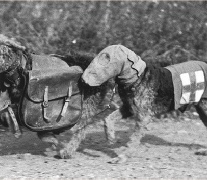
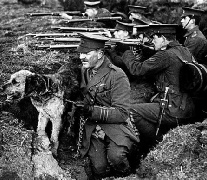
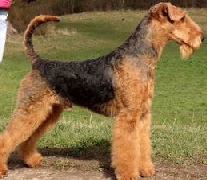
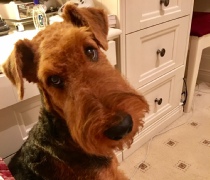
AIREDALE TERRIER - CHARACTERISTICS
Personality
Airedale Terriers are hard-
Airedale Terriers have a very playful side to their natures and love to entertain and be entertained. They are known to be a little mischievous when the mood takes them and being so clever, an Airedale quickly learns what pleases an owner and how much they can get away with, bearing in mind that Airedales love to test the limits and boundaries just for the sake of it.
Airedales are natural watchdogs and the need to "protect" is deeply embedded in a dog's psyche. They go about their business seriously and are quick to let an owner know when there are strangers about or when something they don't like is going on around them.
Intelligence / Trainability
The Airedale Terrier is an extremely intelligent dog and in the right hands with the correct amount of training and guidance, these dogs learn quickly and are therefore easy to train. Being terriers, they boast having a strong prey drive which means early socialisation is essential for these dogs to accept being around other animals. Their training must include a strong "recall" command right from the start.
Airedales respond well to positive reinforcement training, but they need to be handled firmly and fairly so they understand who is alpha dog in a household. When they know their place in the "pack", Airedales are great family pets as well as very able working dogs. It is important to remind them who is alpha dog from time to time, thanks to the more dominant side to their natures.
Airedale Terrier puppies are very cute and it is all too easy to spoil them when they first arrive in a new home. They are also clever which means they learn new things quickly which includes the bad along with the good. As such, puppies must be taught what is acceptable behaviour and what is not which means laying down rules and boundaries right from the word go. Playtime can be boisterous so it's also a good idea to teach a puppy to play nicely to avoid breakages around the home.
AIREDALE - BREED ORIGIN
The King of the Terriers -
In the mid-
After becoming a show dog, it was crossed with Bull and Irish Terriers, to remove the traits of the Otterhound cross that was not very popular.
By the 20th century, Champion Master Briar, the breed’s patriarch, popularized the dog and his child achieved the same outcome in the U.S. The hunting ability and the size of the Airedale helped the dog become renowned as a big game hunter. The dog has also become a good family pet and a police dog for its manners and smart looks. The period after World War I saw a decline in the dog’s popularity, but today many dog fanciers are fond of the Airedale Terrier.
AIREDALE - HISTORY
The Airedale was extensively used in World War I to carry messages to soldiers behind enemy lines and transport mail. They were also used by the Red Cross to find wounded soldiers on the battlefield. There are numerous tales of Airedales delivering their messages despite terrible injury.
Lieutenant Colonel Edwin Hautenville Richardson was responsible for the development of messenger and guard dogs in the British Army. He, along with his wife, established the British War Dog School at Shoeburyness in Essex, England. In 1916, they provided two Airedales (Wolf & Prince) for use as message carriers. After both dogs proved themselves in battle, Airedales were given more duties, such as locating injured soldiers on the battlefield, an idea taken from the Red Cross.
Before the adoption of the German Shepherd as the dog of choice for law enforcement and search and rescue work, the Airedale terrier often filled this role.
In 1906, Richardson tried to interest the British Police in using dogs to accompany officers, for protection on patrol at night. Mr. Geddes, Chief Goods Manager for Hull Docks in Yorkshire, was convinced after he went and saw the impressive work of police dogs in Belgium. Geddes convinced Superintendent Dobie of the North Eastern Railway Police, to arrange a plan for policing the docks. Airedale Terriers were selected for duty as police dogs because of their intelligence, good scenting abilities and their hard, wiry coats that were easy to maintain and clean. They were trained in Hull to attack people not in uniform which could cause problems for their handlers when off duty. The first four dogs began patrols in Hull Docks in 1908, and the scheme was later extended to other docks policed by the North Eastern Railway Police.
At the beginning of the Russo-
AIREDALE TERRIER - APPEARANCE
Height at the withers: Males 58 -
Average Weight: Males 23 -
Airedales boast being the largest of the terrier group and they have a very distinct and unique look with their proud stance and black and tan coats. These are known as being "broken" when describing terrier breeds. They are powerful and muscular dogs that lean to the cobby side. They hold their long, flat heads proudly which adds to their overall proud look.
Airedale Terriers boast smallish, dark eyes with a distinct intelligent and keen look about them. Their ears have a distinct V-
Their necks are moderate in length and muscular, widening very gradually down to a dog's shoulders which are strong and neatly laid back. Front legs are long and powerful looking and their feet are compact, neat and round. As previously mentioned, the Airedale Terrier has a "cobby" appearance which sees their bodies compact with a short back that's level over a well-
An Airedale's hindquarters boast being powerful with a well-
When it comes to an Airedale's coat, their outer coat is dense and wiry with a slight kink in it and it lies close to a dog's body while their undercoat is much softer and shorter in length. They boast a striking black and tan colour with the "saddle" on their backs being black or grizzle while the rest of their body is a tan colour. Their ears are a slightly darker tan and dogs may have a little bit of shading around their necks and on the side of their heads too which is perfectly acceptable. Occasionally, an Airedale may have some white hairs between their front legs which again is acceptable as a breed standard.